Related Research Articles

Longships were a type of specialised Scandinavian warships that have a long history in Scandinavia, with their existence being archaeologically proven and documented from at least the fourth century BC. Originally invented and used by the Norsemen for commerce, exploration, and warfare during the Viking Age, many of the longship's characteristics were adopted by other cultures, like Anglo-Saxons, and continued to influence shipbuilding for centuries. The longship's design evolved over many centuries, and continuing up until the 6th century with clinker-built ships like Nydam and Kvalsund. The longship appeared in its complete form between the 9th and 13th centuries. The character and appearance of these ships have been reflected in Scandinavian boat-building traditions until today. The particular skills and methods employed in making longships are still used worldwide, often with modern adaptations. They were all made out of wood, with cloth sails and had numerous details and carvings on the hull.

The Viking Age was the period during the Middle Ages when Norsemen known as Vikings undertook large-scale raiding, colonizing, conquest, and trading throughout Europe, and reached North America. It followed the Migration Period and the Germanic Iron Age. The Viking Age applies not only to their homeland of Scandinavia, but to any place significantly settled by Scandinavians during the period. The Scandinavians of the Viking Age are often referred to as Vikings as well as Norsemen, although few of them were Vikings in the technical sense.
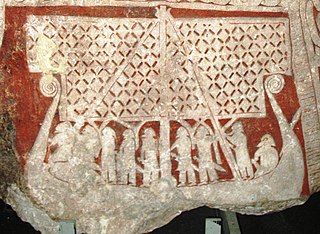
Vikings were the seafaring Norse people from southern Scandinavia who from the late 8th to late 11th centuries raided, pirated, traded and settled throughout parts of Europe. They also voyaged as far as the Mediterranean, North Africa, the Middle East, and North America. In the countries they raided and settled, the period is known as the Viking Age, and the term 'Viking' also commonly includes the inhabitants of the Norse homelands. The Vikings had a profound impact on the early medieval history of Scandinavia, the British Isles, France, Estonia, and Kievan Rus'.

A sailing ship is a sea-going vessel that uses sails mounted on masts to harness the power of wind and propel the vessel. There is a variety of sail plans that propel sailing ships, employing square-rigged or fore-and-aft sails. Some ships carry square sails on each mast—the brig and full-rigged ship, said to be "ship-rigged" when there are three or more masts. Others carry only fore-and-aft sails on each mast—schooners. Still others employ a combination of square and fore-and aft sails, including the barque, barquentine, and brigantine.

In naval architecture, a poop deck is a deck that forms the roof of a cabin built in the rear, or "aft", part of the superstructure of a ship.

Viking ships were marine vessels of unique structure, used in Scandinavia from the Viking Age throughout the Middle Ages. The boat-types were quite varied, depending on what the ship was intended for, but they were generally characterized as being slender and flexible boats, with symmetrical ends with true keel. They were clinker built, which is the overlapping of planks riveted together. Some might have had a dragon's head or other circular object protruding from the bow and stern for design, although this is only inferred from historical sources. Viking ships were not just used for military purposes, but for long-distance trade, exploration and colonization.

The Gokstad ship is a 9th-century Viking ship found in a burial mound at Gokstad in Sandar, Sandefjord, Vestfold, Norway. It is displayed at the Viking Ship Museum in Oslo, Norway. It is the largest preserved Viking ship in Norway.

The Oseberg ship is a well-preserved Viking ship discovered in a large burial mound at the Oseberg farm near Tønsberg in Vestfold county, Norway. This ship is commonly acknowledged to be among the finer artifacts to have survived from the Viking Era. The ship and some of its contents are displayed at the Viking Ship Museum at Bygdøy on the western side of Oslo, Norway.
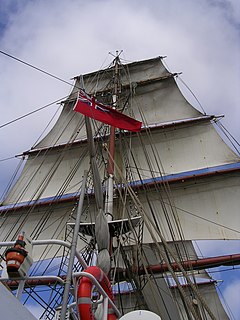
Square rig is a generic type of sail and rigging arrangement in which the primary driving sails are carried on horizontal spars which are perpendicular, or square, to the keel of the vessel and to the masts. These spars are called yards and their tips, beyond the last stay, are called the yardarms. A ship mainly rigged so is called a square-rigger.
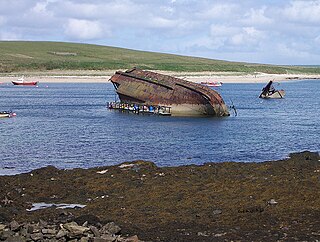
A blockship is a ship deliberately sunk to prevent a river, channel, or canal from being used. It may either be sunk by a navy defending the waterway to prevent the ingress of attacking enemy forces, as in the case of HMS Hood at Portland Harbour in 1914; or it may be brought by enemy raiders and used to prevent the waterway from being used by the defending forces, as in the case of the three old cruisers HMS Thetis, Iphigenia and Intrepid scuttled during the Zeebrugge raid in 1918 to prevent the port from being used by the German navy.
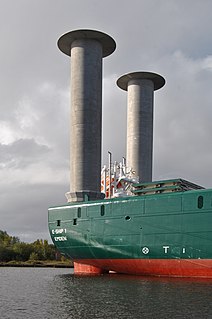
A rotor ship is a type of ship designed to use the Magnus effect for propulsion. The ship is propelled, at least in part, by large powered vertical rotors, sometimes known as rotor sails. German engineer Anton Flettner was the first to build a ship that attempted to tap this force for propulsion, and ships using his type of rotor are sometimes known as Flettner ships.
SS Viking was a wooden-hulled sealing ship made famous by its role in the 1931 film The Viking. During her use in the seal hunt in Newfoundland, the ship was twice commissioned by the film crew. During production, an explosion destroyed the ship, resulting in the loss of the director, Varick Frissell and the cinematographer, Alexander Gustavus Penrod, in addition to the lives of 26 of the ships' crew and film crew.

The siege of Paris of 885–886 was part of a Viking raid on the Seine, in the Kingdom of the West Franks. The siege was the most important event of the reign of Charles the Fat, and a turning point in the fortunes of the Carolingian dynasty and the history of France. It also proved for the Franks the strategic importance of Paris at a time when it also was one of the largest cities in West Francia. The siege is the subject of an eyewitness account in the Latin poem Bella Parisiacae urbis of Abbo Cernuus.
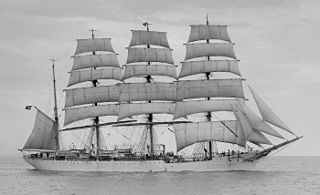
Viking is a four-masted steel barque, built in 1906 by Burmeister & Wain in Copenhagen, Denmark. She is reported to be the biggest sailing ship ever built in Scandinavia. In the 21st century her sailing days have drawn to a close, and is now moored as botel in Gothenburg, Sweden.

The Skuldelev ships are five original Viking ships recovered from the waterway of Peberrenden at Skuldelev, c. 20 km (12 mi) north of Roskilde in Denmark. In 1962, the remains of the submerged ships were excavated in the course of four months. The recovered pieces constitute five types of Viking ships and have all been dated to the 11th century. They were allegedly sunk to prevent attacks from the sea. When the remains were unearthed, they were thought to comprise six ships, but "Skuldelev 2" and "Skuldelev 4" were later discovered to be parts of one ship.
A prize crew is the selected members of a ship chosen to take over the operations of a captured ship. Prize crews were required to take their prize to appropriate prize courts, which would determine whether the ship's officers and crew had sufficient cause to have the value of the prize awarded to them.

USS General M. B. Stewart (AP-140) was a General G. O. Squier-class transport ship for the U.S. Navy in World War II. She was named in honor of U.S. Army general Merch Bradt Stewart. She was transferred to the U.S. Army as USAT General M. B. Stewart in 1946. On 1 March 1950 she was transferred to the Military Sea Transportation Service (MSTS) as USNS General M. B. Stewart (T-AP-140). She was later sold for commercial operation under the name SS Albany, before being scrapped in July 1987.
Pride of Le Havre was the name of ferry for P&O Ferries that sailed between Portsmouth and Le Havre from 1989 to 1994. From launch until 1994, she was known as the Viking Valiant for Townsend Thoresen and P&O. In 1994 she was renamed Pride of Cherbourg2 for P&O and continued under this name until she was sold to El Salam Maritime in 2002. El Salam Maritime renamed her Pride of Al Salam 1 for El Salam Maritime. In 2004 she was renamed Nador and chartered to Comanav, she was again renamed Mogador for Comanav in 2005, sailing under this name until being scrapped in 2010.

Íslendingur is a replica of the Gokstad viking ship and was sailed across the Atlantic Ocean in 2000. It is on display at the Viking World museum in Njarðvík, Reykjanesbær, Iceland.
The Viking raid on Išbīliya, then part of the Umayyad Emirate of Córdoba, took place in 844. After raiding the coasts of what is now Spain and Portugal, a Viking fleet arrived in Išbīliya through the Guadalquivir on 25 September, and took the city on 1 or 3 October. The Vikings pillaged the city and the surrounding areas. Emir Abd ar-Rahman II of Córdoba mobilized and sent a large force against the Vikings under the command of the hajib (chief-minister) Isa ibn Shuhayd. After a series of indecisive engagements, the Muslim army defeated the Vikings on either 11 or 17 November. Seville was retaken, and the remnants of the Vikings fled Spain. After the raid, the Muslims raised new troops and built more ships and other military equipment to protect the coast. The quick military response in 844 and the subsequent defensive improvements discouraged further attacks by the Vikings.
References
- ↑ "Glossary of Viking Words". Archived from the original on 2007-09-30.
- ↑ Grambs, David (1993). Did I Say Something Wrong?. Penguin Group. p. 75. ISBN 0-452-26831-1.
- ↑ Gedney, Elias. Ships and Navigation of the SCA Period (PDF). East Kingdom Guild of St Erasmus. p. 11.